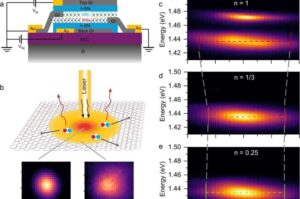
A team of astronomers from Rhodes University and other institutions has conducted an extensive analysis of 104 quasars identified in the MIGHTEE survey, a project utilizing the MeerKAT telescope in South Africa. Their findings, published on July 16, 2025, on the preprint server arXiv, aim to enhance understanding of these distant celestial objects and their characteristics.
Quasars, or quasi-stellar objects (QSOs), represent some of the brightest entities in the universe, acting as essential tools in astrophysics and cosmology. These objects are classified as active galactic nuclei (AGN) with remarkable luminosity, emitting electromagnetic radiation across various wavelengths including radio, infrared, and X-rays. The MIGHTEE survey seeks to capture deep images of the extragalactic sky, contributing significantly to research on cosmic evolution and galaxy formation.
Insights from the MIGHTEE Data
The research team, led by Sarah V. White, focused on unobscured type I quasars, known for their broad emission lines. By selecting quasars through gJK color-space, the astronomers examined objects with a 1.3-GHz flux density threshold of approximately 3.0 μJy beam −1. The comprehensive datasets available from the COSMOS and XMM-LSS fields provided a robust foundation for assessing both radio-loud and radio-quiet quasars.
The sample’s redshifts ranged from 0.6 to 3.41, with a median redshift around 1.68. The study estimated that about 5% of the quasars analyzed were radio-loud, a figure consistent with previous research findings. Notably, the researchers observed that the fraction of quasars with radio emissions dominated by the AGN was lower than that found in other studies within the MIGHTEE sample. This discrepancy may be attributed to the radio flux-density limit of the images, which enhances sensitivity to lower radio luminosities related to star formation.
Implications for Future Research
The research also revealed a significant increase in the proportion of potential starburst galaxies among higher redshift quasars. The incidence of starbursts escalated from 31–38% to 63% in the highest redshift group. According to the authors, this trend complicates the application of the “radio-excess” method to determine whether the AGN primarily influences total radio emissions in these systems.
The findings suggest a need for refined methods in selecting and analyzing AGNs to account for the higher occurrence of starbursts at elevated redshifts. As the study progresses, these insights could reshape our understanding of quasars and their role in the broader cosmic landscape.
In summary, this investigation not only enhances the scientific community’s knowledge of quasars but also paves the way for more nuanced approaches in future astrophysical research. The work conducted by White and her colleagues exemplifies the importance of collaborative efforts in advancing our understanding of the universe.







